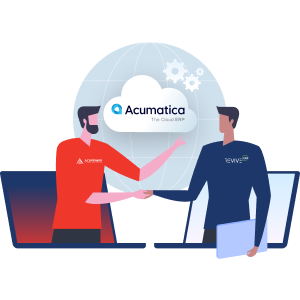
The Primary Types of Cloud Computing: Deployment Models, Service Models, and Major Vendors
While implementing and explaining Acumatica ERP, we often asked about cloud computing. In order to cover that gap in knowledge, we want to write quite a descriptive article about cloud computing. Cloud computing has quickly emerged as the foundation underpinning digital business transformation initiatives across industries. However, with the sheer diversity of cloud technology options now available, it's essential for technology leaders to understand the primary types of cloud computing models, services, and providers in order to strategize the optimal solutions for driving innovation and growth.

This in-depth guide serves as a definitive reference covering the prominent categories of cloud computing based on deployment approaches, service delivery types, and leading vendor ecosystem solutions. We’ll explore public, private, and hybrid cloud architectures, SaaS, PaaS, and IaaS services, as well as key offerings from dominant providers like Amazon Web Services (AWS), Microsoft Azure, Google Cloud Platform, IBM Cloud, and Alibaba Cloud. Let's dive in to uncover the vast potential of cloud computing.
Defining the Major Cloud Deployment Models
There are three principal models for architecting cloud environments based on the location of the cloud resources and how they are provisioned and accessed by cloud services consumers:
Public Cloud Promises Ubiquitous, Scalable Access
The public cloud deployment model represents the most widely leveraged approach to accessing cloud computing today. Public cloud services offer on-demand, self-service access to rapidly scalable computing power, platforms, storage, and applications using massive resource pools hosted at public cloud data centers operated by hyperscale vendors.
Leading public cloud providers today consist of Amazon Web Services (AWS), Microsoft Azure, Google Cloud Platform, IBM Cloud, Alibaba Cloud, and Oracle Cloud. Instead of constructing their own data centers, organizations leverage these public cloud providers’ vast global infrastructure footprints with data centers spread across continents, tapping into shared public cloud resources. This allows small businesses and large enterprises alike to access the latest technology innovations.
Public cloud services are delivered over the internet and involve a multi-tenant architecture, with physical infrastructure and resources shared securely between organizations. Adopting a public cloud model provides simplicity, versatility, and significant cost efficiencies since organizations don’t have to architect, procure, configure, or maintain the immense underlying data centers and hardware infrastructure themselves.
The public cloud operating model has massively accelerated speed to market and agility innovations, allowing organizations of all sizes to quickly experiment with cutting-edge capabilities thanks to the hyperscale providers’ economies of scale. By reducing lengthy on-premises IT procurement cycles traditionally required before undertaking new projects, public cloud services empower innovating rapidly, launching products faster, and bringing digital solutions to market without upfront capital investments.
Public cloud spending scales elastically based on monthly metered workload consumption rather than overprovisioning potentially idle local infrastructure. The unlimited capacity and abundance of services available from leading public cloud vendors are resulting in surging adoption across industries. However, moving to the public cloud requires organizations to cede direct control over workloads and rely on providers for security and regulatory compliance. For use cases with stringent local oversight needs, companies often utilize hybrid cloud configurations.
Private Cloud Facilitates Customized Control
In contrast to leveraging shared public cloud resources, the private cloud refers to exclusive cloud computing environments built for access and usage by a single organization hosted on a private network, including data center infrastructure operated solely for that organization. Rather than utilizing public cloud services operated externally by vendors, private cloud provides dedicated hardware, storage, networking and compute capacity controlled entirely within the organization's firewall perimeters and governed completely by internal administration teams.
Private cloud deployments facilitate much greater customization of cloud resources to meet an organization's specific criteria around security protocols, governance risk and compliance benchmarks, access controls, application performance SLAs, availability metrics, and other IT policies. Maintaining sensitive data, regulated workloads, and mission-critical applications in a private cloud setting located on-premises or hosted at a colocation facility allows for enforcing organizational oversight based on internal standards and active directory policies beyond the control of external public cloud providers.
Of course, owning the responsibility for architecting, acquiring, operating, and maintaining private cloud infrastructure elements like servers, storage, backup, virtualization orchestration, and hypervisors results in greater capital and ongoing expenses compared to public cloud subscription services. Lacking the IT resource automation, utilization optimization, and technical specialization of public cloud vendor administrations, the complexity around configuring and keeping private cloud deployments operational can also intensify without adequate investments and expertise. However, for some organizations and heavily regulated use cases, private cloud ownership facilitates necessary data control and risk mitigation, enforcing internal compliance requirements.
Hybrid Cloud Bridges Public and Private Environments
The hybrid cloud computing model combines public cloud services with private cloud and on-premises IT infrastructure together in a unified, tightly integrated architecture. Organizations can leverage the most optimal combination of public, private, and legacy IT environments to host different workloads based on criteria spanning security risks, demand fluctuations, capacity requirements, and regulatory restrictions.
For example, highly regulated or proprietary on-premises systems can fulfill compliance and data sovereignty mandates, while customer-facing web applications leverage expansive public cloud backend processing capabilities and content delivery networks to optimize performance and scalability for users. Shared services from public clouds maintain flexibility, while mission-critical core backend processes operate from private data centers. This “hybrid cloud strategy” grants flexibility concerning optimal workload placement and migration options across mixed environments, accounting for agility, control, and costs across public cloud consumption and existing IT assets.
Although integrating separate public, private, and legacy IT operating environments increases overall hybrid cloud complexity, modern cloud management platforms, and infrastructure automation assist with bridging these heterogeneous spheres cleanly. With turnkey hybrid cloud management solutions and cloud interoperability standards, integrating multi-cloud architecture has become more seamless to prevent cloud silos and vendor lock-in while fulfilling data residency regulations.
Let's drill deeper into the established cloud computing service models for actually building, running, and delivering workloads across these deployment infrastructure options next.
Reviewing Primary Cloud Service Models
In addition to choosing deployment models concerning resource location, administrations, and access, adopting cloud computing requires selecting from service models that categorize how cloud services are provisioned, consumed, and managed:
IaaS Enables Instant Infrastructure Access
Infrastructure-as-a-Service (IaaS) constitutes the most flexible and scalable cloud model, delivering fundamental computing infrastructure resources, including servers, storage, networking, data centers, and hardware systems on demand over the internet. Rather than installing physical data center hardware, with IaaS, organizations can instantly spin up and down cloud-hosted virtual infrastructure capacity on the fly through self-service dashboards.
Leading IaaS examples include Amazon Elastic Compute Cloud (EC2) virtual servers, EBS block storage volumes, VPC software-defined cloud networking, along with Microsoft Azure Virtual Machines, Google Compute Engine VMs, Oracle Cloud Compute, and more. Overall, IaaS massively empowers IT agility since organizations don’t have pre-purchase hardware they may underutilize across fluctuating workloads. The real-time ability to scale infrastructure capacity up and down dynamically based on granular usage metrics allows for optimizing cloud costs accordingly.
PaaS Provides Built-in Application Services
Platform-as-a-Service (PaaS) goes beyond fundamental IaaS infrastructure to offer integrated cloud application development and delivery platforms, enabling developers to code cloud-native apps without configuring underlying resources. Well-known PaaS examples include AWS Elastic Beanstalk, Azure App Service, Google App Engine, Red Hat OpenShift, and more.
These preconfigured application platforms automate coordinating OSes, middleware, databases, storage, and networking components needed to build modern applications while inserting DevOps automation for continuous testing and deployment. Developers simply push code repos to the unified PaaS environment to streamline building compelling apps faster without manual infrastructure wrangling. Specialized on-demand cloud services for machine learning, blockchain, IoT, analytics, and databases empower innovation.
For cloud application development teams, PaaS cloud computing minimizes undifferentiated infrastructure burdens to maximize solution delivery and business value generation atop managed cloud app platforms optimized for scale and reliability. PaaS drives focus exclusively on crafting brilliant digital experiences rapidly.
SaaS Provides Cloud-Hosted Software Apps
Representing the most turnkey and prolific cloud model today, Software-as-a-Service (SaaS) enables users to utilize full-featured software applications hosted centrally and accessible over the internet as scalable on-demand services using slim, lightweight client interfaces on devices. SaaS eliminates needing to install, configure, patch and upgrade thick traditional desktop programs personally.
Prominent SaaS application examples include ubiquitous productivity suites like Google Workspace, Microsoft 365, and Apple iWork for creating documents or spreadsheets from any browser, along with specialized solutions spanning Salesforce CRM, Workday HCM, HubSpot marketing software, Tableau analytics, GitHub code repositories, DocuSign e-signature workflows and infinitely more. End users can conveniently access the latest innovative apps running within the providers’ distributed public clouds through slim apps and web interfaces instantly without local installation.
For IT teams, SaaS liberates from substantial testing, patching, upgrade and license management headaches associated with traditional on-premises software deployments. IT can easily scale software consumption up and down across the business using cloud provider APIs as the adoption of new SaaS capabilities grows. SaaS empowers supreme agility around accessing the most current collaboration solutions on-demand to meet evolving business challenges.
Now, let's dive deeper into the leading cloud computing vendors providing cloud infrastructure environments and services across these deployment and service models using their global scale, specialization, and partnerships.
Analyzing Notable Cloud Computing Vendors
Many technology providers offer cloud computing platforms and services aligned to the various cloud model combinations, but the most dominant global-scale providers unlock tremendous innovation across deployments, development capabilities, and industry solutions:
Amazon Web Services (AWS)
The undisputed public cloud market leader for over a decade, Amazon Web Services (AWS) maintains unprecedented momentum across its continuously expanding array covering hundreds of IaaS, PaaS, and SaaS technologies. AWS empowers globally distributed workloads across data analytics, containers, cybersecurity, machine learning, media services, blockchain, quantum computing, and much more, fueled by its industry-leading infrastructure scale and availability across 77 Availability Zones and 24 geographic regions. Acumatica ERP, by itself, uses mostly AWS. Acumatica works perfectly fine on Azure but prefers its AWS.
Microsoft Azure
With strong enterprise roots, Microsoft Azure's public and hybrid cloud platform continues growing rapidly thanks to over $1 billion in annual R&D investment. Azure offers over 200 mature IaaS and PaaS services accessible across 54 global regions, enabling next-generation solutions. Tight integration with Microsoft’s ecosystem from Office 365 to Dynamics 365 CRM, Power Platform, and GitHub, along with robust infrastructure, AI, and blockchain cloud capabilities, brings tremendous value to builders and businesses.
Google Cloud Platform (GCP)
Leveraging Google's privately built high-capacity fiber network infrastructure globally, Google Cloud Platform (GCP) delivers high-scale, low-latency public cloud services, including IaaS, PaaS, data analytics, artificial intelligence (AI), and machine learning (ML) across 34 regions currently. GCP provides Linux and Windows Server IaaS along with Kubernetes container orchestration. Unique PaaS, analytics, big data, cybersecurity, and ML technologies include BigQuery, Looker, Cloud Spanner, Vertex AI, Dataflow, and more.
IBM Cloud Services
IBM Cloud services blend public cloud reach and private cloud platforms for hybrid cloud leadership focused on complex enterprise workload migration flexibility. Next-generation bare metal and virtualized processing power for cloud interconnects easily to existing IBM Z mainframes, IBM Power Systems, storage systems, and mainstream public clouds. Over 180 IaaS and PaaS solutions spanning infrastructure, containers, security, blockchain, and quantum leveraging Red Hat OpenShift highlight IBM Cloud's services depth.
Alibaba Cloud
With strength serving Chinese workloads and leading regional expansion, Alibaba Cloud provides comprehensive hyperscale public and hybrid cloud computing services, including IaaS, PaaS, SaaS, big data, machine learning, and Internet of Things (IoT) capabilities across 25 global regions. Backed by leadership in China and $15 billion in R&D funding through 2025, Alibaba Cloud boasts a particular specialty with e-commerce, finance, logistics, and digital media demands, along with $1 billion investment in upstream and downstream semiconductor chip R&D through its Pingtouge semiconductor subsidiary.
Key Takeaways and Future Outlook
Let’s quickly recap some of the central themes around selecting cloud environments and services to propel business ambitions ahead:
Deployment Models
- Public clouds allow tapping into near-infinite on-demand capacity
- Private clouds fulfill customer-specific controls and policies
- The hybrid model balances public cloud agility with private control
Service Models
- IaaS enables instant, flexible infrastructure provisioning
- PaaS speeds up building cloud-native apps using managed services
- SaaS provides ubiquitous access to the latest cloud-hosted software
Dominant Vendors
- AWS leads in public cloud adoption across exponential services
- Microsoft Azure aligns strong Microsoft software ecosystem integration
- GCP powers unmatched computing speed, analytics, and ML capabilities
- IBM melds public cloud and private cloud for hybrid cloud coherence
- Alibaba Cloud brings specialized Chinese and Asia-centric expertise
The year ahead features increasing adoption of hybrid cloud and multi-cloud computing across mixing localized and centralized environments, IaaS building blocks, PaaS development platforms, and ubiquitous SaaS applications. It’s evident organizations can leverage these coordinated cloud service model combinations spanning deployment approaches and leading provider ecosystems in order to accelerate digital solutions development and unbound business possibilities.
By strategically aligning the right public cloud, private cloud, and hybrid platform configurations for targeted workloads, modern enterprises can drive technology innovation faster to unlock growth while maintaining control over mission-critical areas. Understanding the types of cloud computing comprehensively is foundational to crafting an optimized cloud architecture and migration roadmap that fulfills both near-term and long-term transformation goals ahead.
Comments (0)
No comments yet
Be the first to comment
 Share on Facebook
Share on Facebook
 Share on LinkedIn
Share on LinkedIn
 Share on Twitter
Share on Twitter


 1158
1158

